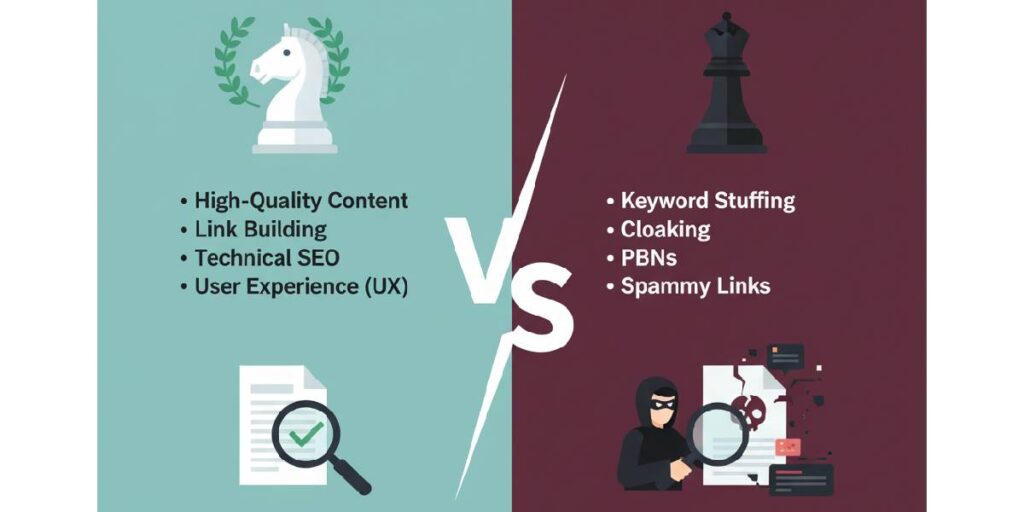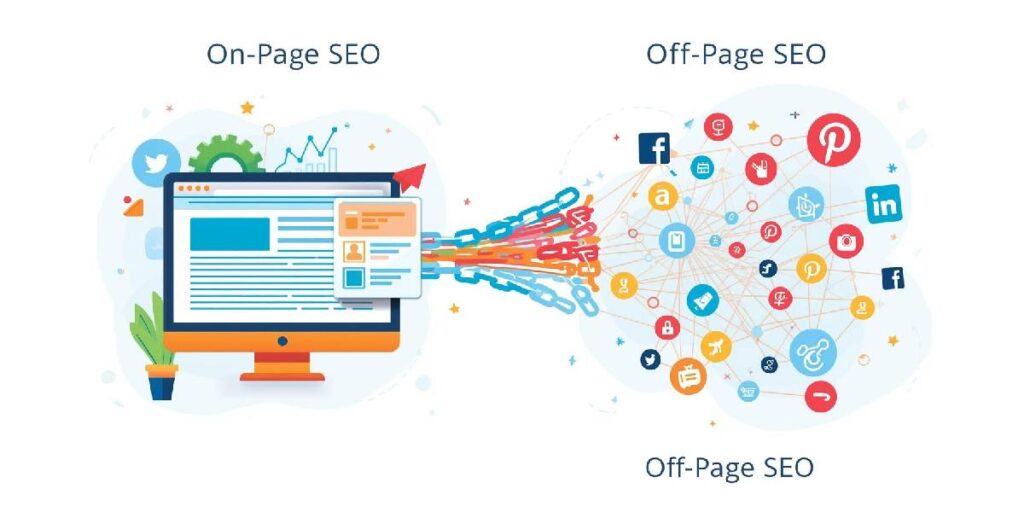SEO (Search Engine Optimization) helps your website rank higher on search engines, such as Google’s search results. While AEO (Answer Engine Optimization) helps your content appear directly as answers in AI tools and voice searches, like Google’s AI Overviews, ChatGPT, Meta, Claude, Bing Copilot, Grok responses, and more.
In short, SEO brings visitors to your website. AEO brings your answers to the user. Before they even visit your site.
Still, different factors and elements differ AEO from SEO. This blog will elaborate on those differences, discussing AEO vs. SEO in detail.
Key Takeaways
- SEO = Visibility on Google search pages.
- AEO = Visibility in AI-driven answers (AI Overviews, voice search, ChatGPT).
- SEO focuses on keywords, links, and user experience.
- AEO focuses on clarity, structured data, and direct answers.
- Neither replaces the other. They work best together for a full online presence.
- AEO is growing fast, but SEO remains the foundation for every digital strategy.
Let’s Get To Know AEO and SEO First
What Is SEO?
SEO (Search Engine Optimization) means improving your website so that it appears higher in Google’s search results when people look for products, services, or information. SEO is the process of helping search engines clearly understand what your website is about and why it deserves to show up against certain keywords or search terms. When your content matches user intent (what people are searching for and why), Google ranks your site higher, bringing more visitors and potential customers.
SEO focuses on making your website relevant, user-friendly, and trustworthy, not just for Google, but also for real users who land on it. It’s about creating helpful content, choosing the right keywords, improving page speed, and earning credibility through other reputable sites linking to you.
SEO (Search Engine Optimization) helps your website rank higher on Google’s search results. It’s about building relevance, authority, and user trust. If you’re ready to grow your organic visibility, explore our professional SEO services, designed to help businesses rank higher, attract quality traffic, and convert leads effectively.
What Is AEO?
AEO stands for Answer Engine Optimization. In AEO, instead of ranking for links, you optimize your content to appear directly as an answer when people ask questions in AI tools or voice searches.
AEO helps your content talk to AI systems. Whether someone types a question in ChatGPT, asks Siri, or searches through Google’s AI Overview, AEO ensures that your page provides the most accurate, clear, and direct response that these systems can trust and display.
You can think of it like preparing your content not just for human readers, but for AI “readers” too. It’s about structuring your content in a way that machines can easily understand context, intent, and answers. So, they can confidently use your content to reply to users.
Let’s say you own a cafe business, have done good SEO & AEO for it, and ask Google Assistant or ChatGPT:
- “What’s the best café near me?”
In response:
- You hear your business name and its website mentioned.
That’s AEO in action!
Major Differences: SEO vs AEO

SEO and AEO share the same goal (visibility). But they work differently to achieve it. SEO helps search engines rank your pages. AEO helps AI tools understand content on those pages and show it to the user as AI answers or responses. Both are essential, but each one focuses on a different stage of user interaction.
Here’s a quick breakdown, clarifying AEO vs SEO differences.
| Factor | SEO (Search Engine Optimization) | AEO (Answer Engine Optimization) |
| Primary Focus | Ranking web pages on Google and other search engines | Getting content selected as a direct answer by AI systems |
| Goal | Attract website clicks and organic traffic | Deliver clear, ready-to-use answers within AI responses |
| Content Style | In-depth, keyword-driven, structured for reading | Concise, question-based, structured for quick answers |
| Optimization Target | Search engine algorithms | AI systems, voice assistants, and answer engines |
| Metrics | Rankings, traffic, and click-through rates | Snippet inclusion, AI overview visibility, and answer mentions |
| Content Length | Long-form and comprehensive | Short, direct, and context-rich |
| Technical Elements | Meta tags, backlinks, site speed, mobile-friendliness | Schema markup, structured data, semantic clarity |
| Devices/Platforms | Desktop, mobile, tablets | Voice search, chatbots, AI-driven tools |
| User Intent | Broad (informational, transactional, navigational) | Specific (question-and-answer intent) |
| Best Use Case | Businesses aiming for organic visibility and traffic | Brands wanting visibility in AI or voice-generated answers |
1. Primary Focus
The main objective behind each approach. It defines what you’re optimizing for: visibility, traffic, or direct answers. In AEO, the focus is on making your content easily understood by AI tools so they can pick it up as the best answer. It’s about clear, structured, factual responses.
On the other hand, the goal of SEO is to get your website pages ranked higher in search results. It’s about making your site relevant, trustworthy, and valuable for both users and search engines.
2. Goal
The goal is another prominent factor that differs AEO from SEO. It means what end result you want from your efforts, clicks, leads, or instant visibility.
In AEO, the goal is to appear inside AI-generated responses or voice answers, giving users a ready solution instantly. You win visibility even without clicks.
In SEO, the goal is to bring users to your website through high search rankings. It’s all about growing organic traffic and long-term reach.
3. Content Style
Both SEO and AEO depend on how your content communicates. Well-structured, helpful writing not only ranks better but also helps AI systems identify your expertise. Our content writing services deliver SEO-optimized, reader-friendly articles that improve engagement and ranking potential.
AEO prefers short, direct, and conversational content that answers questions clearly. Structured sections, definitions, and FAQs work best. On the other hand, SEO uses longer, in-depth content that explains a topic thoroughly. It’s often keyword-driven, detailed, and designed to hold readers’ attention.
4. Optimization Target
The optimization target clarifies for which platform or system your content is optimized.
AEO Targets AI systems like ChatGPT, Google’s AI Overviews, or voice assistants. It’s about helping these tools instantly understand your meaning and facts. While SEO targets traditional search engines such as Google and Bing. It works by improving site structure, keywords, and backlinks to help ranking algorithms.
5. Metrics
Metrics show what’s working and what’s not.
AEO metrics look at how often your content appears in AI answers or featured snippets. It focuses more on visibility inside AI-generated responses than on clicks.
SEO metrics track rankings, impressions, and organic traffic. It’s measured by how many people visit your website and engage with your pages.
6. Content Length
The depth of content matters because people and platforms prefer different formats. Therefore, AEO favors concise, factual, and neatly structured paragraphs that can be read or spoken easily. For example, short answers and summaries perform better. While SEO works better with long-form content that fully covers a topic. For example, comprehensive blogs, guides, and service pages rank higher.
7. Technical Elements
Technical elements are the behind-the-scenes signals that help systems read and rank your content.
AEO relies on schema markup, structured data, and clarity of meaning in each of your website’s content. These help AI engines extract precise answers quickly.
SEO involves technical aspects like meta tags, backlinks, and site speed. These elements improve visibility and help search engines crawl and index pages effectively.
Behind every successful SEO and AEO strategy lies strong technical optimization. Factors like website speed, schema, and crawlability decide whether your content gets noticed. Our technical SEO services ensure your website structure supports higher rankings and faster indexing.
8. Devices & Platforms
Before you optimize your online presence, you should know which optimization approach works best for which channel through which your target audience accesses your content.
AEO dominates in voice searches, AI platforms, and large language models (LLMs) like Google Assistant, Siri, or ChatGPT. It’s built for spoken queries and conversational results.
SEO performs best across traditional web search platforms. It targets people using browsers on desktops, mobiles, and tablets. Those who still scroll, compare, and click through search results to explore websites in detail.
9. User Intent
User intent is simply the reason behind the search or question.
AEO focuses on specific questions or quick problem-solving intent. It’s designed to give one accurate, time-saving answer. While SEO covers a wider range from information gathering to product comparison or purchase intent. It supports every step of the user journey.
10. Best Use Case
AEO is ideal for brands wanting visibility in AI summaries, voice search, or quick-answer platforms. It suits informational and how-to content.
SEO is best for building long-term organic reach, lead generation, and brand authority through full web visibility.
Common Mistakes People Make (and What to Watch Out For)

1. Misunderstanding AEO
- Many think AEO just means adding short answers everywhere. It’s not.
- AEO is about understanding the question behind the query and offering a complete, accurate response. If your content doesn’t actually solve something, AI tools won’t show it.
2. Copying Short Answers Without Depth
- Some businesses try to mimic AI-style summaries by posting shallow, one-line answers.
- But AI and search systems prefer context-rich content, where a short answer is followed by supporting details or facts.
3. Ignoring User Intent
- Writing content without understanding why someone is searching is one of the biggest mistakes.
- You must match your answer’s tone, structure, and depth to what the user actually wants, whether it’s a quick fact, a how-to, or a product solution.
4. Over-Optimizing for Answer Boxes
- Stuffing too many “what is” or “how to” phrases, or repeating the same keywords everywhere, hurts visibility.
- Modern AI systems can detect forced optimization. Instead, focus on natural, conversational phrasing that sounds human and helpful.
Future Trends: How AEO + SEO Will Evolve
1. AI Evolution
AI is reshaping how information is discovered and displayed.
Search engines are no longer just listing links. They’re understanding intent and delivering context-based answers.
According to PwC, AI could contribute up to $15.7 trillion to the global economy by 2030.
That means AI-backed systems like Google’s Search Generative Experience (SGE) and ChatGPT-powered engines will continue blending AEO and SEO for smarter, answer-driven visibility.
2. Multimodal Search (Voice, Video, and Visuals)
Search is no longer just about text.
With Google Lens handling more than 12 billion visual searches per month, and voice searches accounting for 20% of all mobile queries, users expect instant answers through multiple formats.
Future-ready strategies will combine AEO’s conversational approach with SEO’s visual and contextual optimization. It ensures your brand appears whether someone types, speaks, or snaps a picture.
3. Personalization & Local Answer Targeting
Search engines and AI tools are getting hyper-personalized.
They now factor in location, device, past searches, and even user preferences to tailor responses.
Over 72% of consumers only engage with content that’s personalized to their interests.
This means businesses that blend local SEO with AEO-optimized conversational content will have the best shot at appearing in location-based and AI-generated results.
Final Thoughts
Every next day, the online world is getting noisy, debating SEO vs AEO.
But remember, SEO isn’t going anywhere – it’s simply evolving.
Also, AEO is not replacing SEO; it’s expanding how visibility works in a world run by AI and voice assistants. Together, they form the new foundation of online discovery.
If you’re already investing in SEO, start adapting your content for AI-driven searches; short, clear, and helpful answers backed by real value. If you haven’t yet, now’s the time to start before your competitors dominate both search and AI results.
SEO and AEO together form the new face of digital visibility. Whether you want to improve your search rankings or get featured in AI-generated answers, Cloudex Marketing can help. Contact us today for a free consultation and discover how we can strengthen your online presence across search and AI platforms.
Frequently Asked Questions About AEO vs. SEO
Below are some of the most common questions people ask when comparing AEO vs. SEO
1. Is AEO just a new name for SEO?
Not really. SEO focuses on ranking web pages in Google results, while AEO (Answer Engine Optimization) focuses on getting your content directly picked by AI tools, chatbots, and voice assistants as the answer. Both serve visibility, just on different platforms and user behaviours.
2. When to Use AEO, When SEO, and When Both?
If you’re running a local business (like a café or salon), SEO helps people find you on Google Maps and search results.
If your audience uses AI tools or voice searches, AEO helps them get instant answers about your brand.
For e-commerce and startups, a hybrid approach works best where SEO brings traffic, while AEO builds authority across AI-driven platforms.
3. How to Integrate AEO into Your Existing SEO Strategy?
To integrate AEO into existing SEO strategy, you should start with structure. Then also use FAQ sections, schema markup, and conversational headings so AI tools can easily pull context. You can reshape long blogs into Q&A-style segments and layer content, starting with a short answer, then a deeper explanation.
4. Does AEO Affect Google Rankings?
Indirectly, yes. When your content earns mentions or citations in AI answers, it increases your brand’s visibility and trust. This can lead to more clicks, shares, and backlinks, all of which strengthen your SEO presence.
5. Can Small Businesses Benefit from AEO?
Absolutely. Voice and AI tools are growing fast here too. By structuring your content clearly and answering customer questions directly, small businesses can appear in AI and voice-generated answers, even competing with bigger brands.






